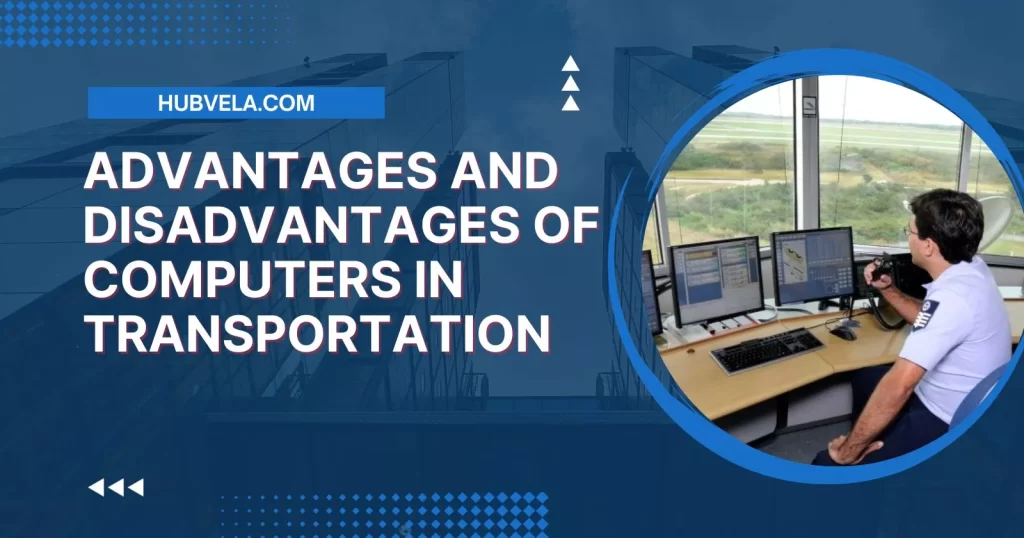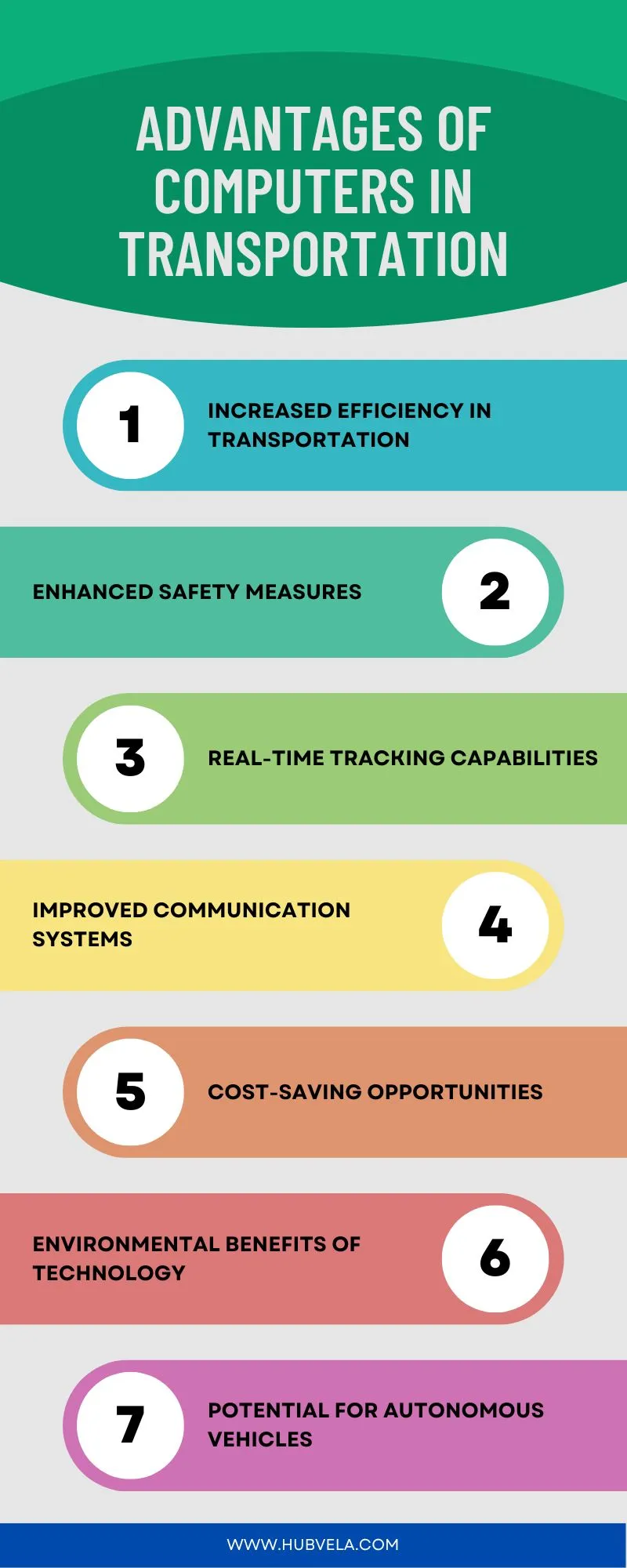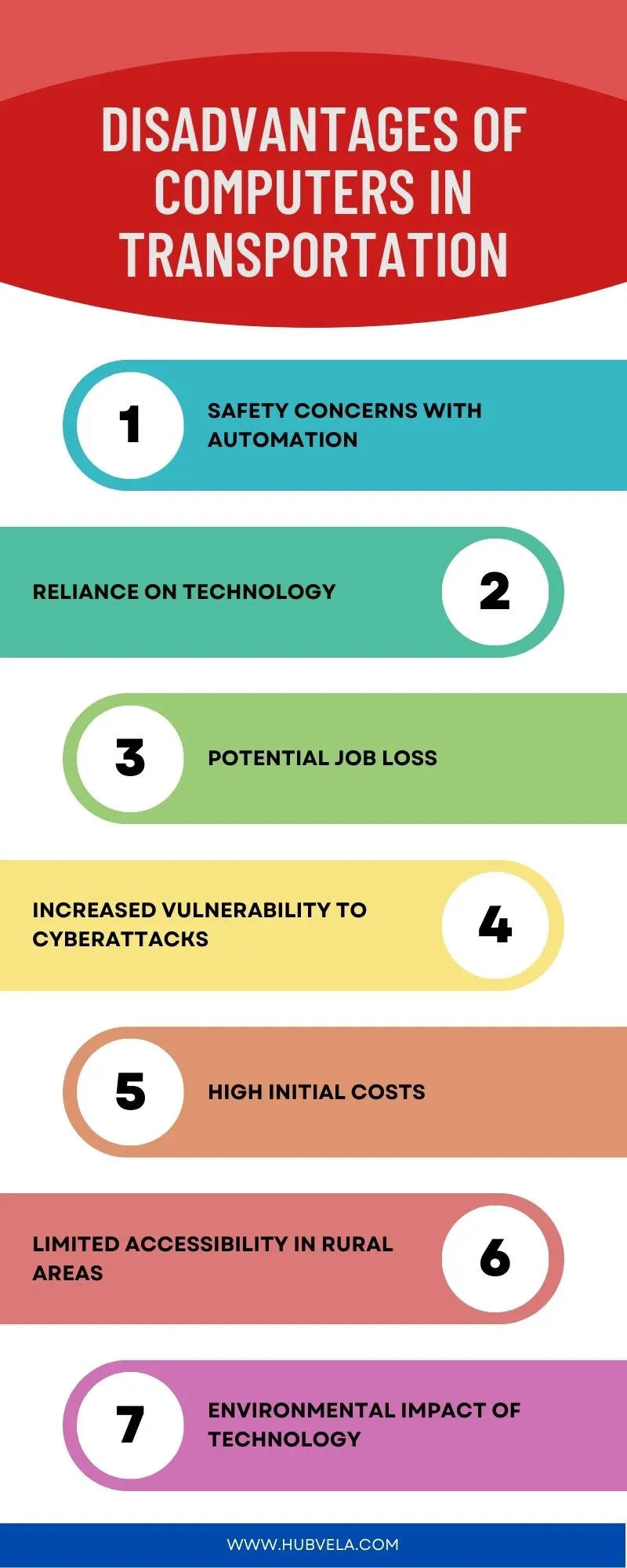Computers have become an integral part of the transportation industry, providing numerous advantages and disadvantages. On the one hand, computers have increased efficiency, reduced the need for human labor, and improved infrastructure.
On the other hand, they have also increased the cost of auto repairs, led to social isolation, and created a dependence on technology.
In this article, we will explore the advantages and disadvantages of computers in transportation in more detail.

--Advertisement--
Advantages of Computers in Transportation
The transportation industry has experienced significant advancements due to the integration of computers and technology.
These advancements have led to improved efficiency, safety, and convenience for passengers and drivers alike. Some of the key benefits of computers in transportation include

1. Increased Efficiency in Transportation
Improve your transportation system’s efficiency by utilizing computers.
By incorporating technology into your transportation operations, you can achieve increased fuel efficiency, improved logistics, reduced traffic congestion, optimized route planning, and enhanced vehicle performance.
Computers can analyze data in real time to determine the most fuel-efficient routes, reducing both costs and environmental impact.
With improved logistics, computers can streamline the movement of goods, ensuring faster and more efficient delivery.
By reducing traffic congestion, computers can help save time and decrease fuel consumption.
Optimized route planning allows for smoother and more efficient transportation, leading to cost savings and improved customer satisfaction.
Additionally, computers can monitor vehicle performance, identify maintenance needs, and maximize efficiency.
2. Enhanced Safety Measures
Enhance transportation safety with the use of computer technology.
Computers have revolutionized the way we ensure safety in transportation. One of the advantages is improved surveillance. With the help of cameras and sensors connected to computers, transportation systems can monitor areas in real-time, detect potential dangers, and take preventive measures.
Another benefit is enhanced emergency response. Computers enable faster communication and coordination between transportation operators and emergency services, allowing for quicker response times and potentially saving lives.
Additionally, computers in transportation provide opportunities for online learning. Drivers and operators can access training materials and simulations, helping them improve their skills and knowledge.
However, it’s crucial to address concerns about data privacy. Proper protocols should be in place to protect sensitive information.
Lastly, the use of computers can also contribute to reduced bullying, as surveillance systems can detect and deter such behavior.
3. Real-Time Tracking Capabilities
With real-time tracking capabilities, computers in transportation allow you to monitor and track vehicles and assets in motion. This technology enables real-time monitoring of transportation systems, enhancing student engagement and personalized learning experiences.
By utilizing data analysis, schools can gather valuable insights into transportation patterns, optimizing routes and schedules to improve efficiency. Real-time monitoring also ensures the safety of students during transportation, allowing for immediate intervention in case of emergencies or delays.
Furthermore, this technology enables schools to track the academic performance of students by analyzing data related to their transportation habits. By identifying correlations between transportation and academic performance, schools can implement targeted interventions to support student success.
4. Improved Communication Systems
Experience seamless and efficient communication systems through the use of computers in transportation. With improved collaboration and efficient information sharing, computers have revolutionized the way people communicate in the transportation industry.
Gone are the days of relying on slow and unreliable communication methods. Computers enable real-time communication between different departments, ensuring that everyone is on the same page and making informed decisions.
Streamlined administrative tasks, such as scheduling and record-keeping, are now easily managed through computer systems, saving time and reducing errors.
Additionally, computers in transportation provide enhanced educational resources for employees, allowing them to access training materials and stay updated on industry trends. This not only improves their knowledge and skills but also increases student engagement and promotes continuous learning.
5. Cost-Saving Opportunities
By utilizing computers in transportation, you can take advantage of cost-saving opportunities. The integration of technology in transportation systems has led to significant savings in various areas.
For example, the use of computerized route planning and optimization software helps to minimize fuel consumption by creating more efficient routes. This not only reduces costs but also contributes to environmental sustainability.
Additionally, computers enable real-time monitoring of vehicle performance, allowing for prompt maintenance and repairs, preventing costly breakdowns.
Furthermore, the digitalization of administrative tasks, such as electronic ticketing and automated invoicing, eliminates the need for paper-based processes, reducing expenses associated with printing and storage.
These cost-saving opportunities not only benefit transportation companies but also contribute to educational benefits. Students can learn about technological advancements in transportation and develop digital literacy skills, leading to improved learning outcomes.
6. Environmental Benefits of Technology
Utilizing computers in transportation offers environmental benefits by reducing fuel consumption and promoting sustainability. By incorporating advanced technologies, such as GPS systems and route optimization software, computers can help reduce emissions by optimizing fuel efficiency and minimizing idle time.
These eco-friendly solutions not only contribute to a cleaner environment but also result in significant cost savings for transportation companies. Moreover, computers enable the implementation of sustainable practices, such as energy conservation and waste reduction, by monitoring and managing fuel consumption in real-time.
This allows for more efficient use of resources and reduces the overall environmental impact of transportation operations. With computers playing a crucial role in the transportation industry, we can strive towards a greener future by embracing technology’s potential for positive change.
7. Potential for Autonomous Vehicles
With computers’ advanced technologies, such as GPS systems and route optimization software, you can harness the potential for autonomous vehicles in transportation, promoting efficiency and reducing emissions.
Autonomous vehicle technology is revolutionizing the future of transportation. Self-driving cars, powered by artificial intelligence (AI), are transforming the way we commute. These driverless vehicles have the ability to navigate through traffic, make decisions based on real-time data, and ensure a safer and smoother ride.
The integration of computers in transportation has the potential to reduce accidents caused by human error and improve overall traffic flow. Additionally, AI in transportation can optimize routes, leading to shorter travel times and less fuel consumption.
Disadvantages of Computers in Transportation
The widespread adoption of computers in the transportation industry has brought numerous advantages, such as improved efficiency, reduced manpower, and enhanced safety.
However, there are also several disadvantages associated with the use of computers in transportation, including:

1. Safety Concerns With Automation
You should frequently be cautious of the safety concerns that arise when relying on automation in transportation.
While automation in transportation has its advantages, such as increased efficiency and reduced human error, there are also several safety risks and ethical implications to consider.
One of the main concerns is the potential for technological limitations. Automated systems may not always function as intended, leading to accidents or malfunctions.
Additionally, human error can still occur when relying on automation, as operators may become complacent or fail to properly monitor the system.
Moreover, there are ethical implications surrounding the use of automated transportation, such as the responsibility for accidents and the potential loss of jobs for human operators.
It’s important to carefully evaluate these concerns and implement appropriate safety measures when utilizing automation in transportation.
2. Reliance on Technology
One significant drawback of relying heavily on technology in transportation is the potential for increased vulnerability. With increased dependence on computers and automation, there’s a higher risk of system failures or hacking, which can compromise the safety and security of transportation networks.
Moreover, the overreliance on technology can have a negative impact on social skills. As people become more engrossed in their devices, they may neglect important face-to-face interactions, leading to a decline in communication skills and interpersonal relationships.
Additionally, the widespread use of technology in transportation can also exacerbate the digital divide, as not everyone has equal access to these resources. This can limit educational opportunities and hinder the ability of certain individuals to fully participate in the digital age.
Lastly, the potential for distraction caused by computers in transportation can pose serious risks, as it diverts attention away from the road and increases the likelihood of accidents.
3. Potential Job Loss
With the increasing integration of computers in transportation, there’s a risk of job loss due to automation and technological advancements. This raises concerns about job security and the potential for technological unemployment.
As computers take over tasks that were once performed by humans, such as driving vehicles or managing logistics, there’s a real possibility of workforce displacement. This trend has significant economic implications, as it could lead to unemployment and a decrease in income for those affected.
Moreover, the societal impact of job loss in the transportation industry can’t be ignored. It may disrupt communities and lead to social unrest.
Therefore, while the use of computers in transportation offers many advantages, it’s essential to carefully consider the potential negative consequences for job security and society as a whole.
4. Increased Vulnerability to Cyberattacks
To further compound the potential negative consequences, the increasing integration of computers in transportation also exposes the industry to a heightened vulnerability to cyberattacks. With this increased reliance on technology comes increased cybersecurity risks, as well as data privacy risks.
The transportation sector is now faced with the challenge of protecting sensitive data and systems from online threats. The digital vulnerabilities within transportation systems make them attractive targets for hackers who may seek to disrupt operations or steal valuable information.
To mitigate these risks, the industry must adopt robust cyber defense strategies. This includes implementing strong encryption protocols, regularly updating software and hardware, conducting thorough risk assessments, and investing in employee training to raise awareness about cyber threats.
5. High Initial Costs
To fully engage with the potential disadvantages of computers in transportation, you must consider the high initial costs associated with implementing and maintaining computer systems in this industry. The cost implications of introducing computers in transportation can be a significant financial burden for organizations. Upgrading existing infrastructure and acquiring new hardware and software can require a substantial investment. Budget constraints may further impede the adoption of computer systems, as organizations may struggle to allocate funds for such projects.
However, it’s vital to recognize that these high initial costs are a long-term investment. Despite the economic feasibility concerns, implementing computer systems can bring numerous benefits to the transportation industry, including improved efficiency, enhanced safety measures, and streamlined operations.
Organizations must carefully evaluate the long-term advantages against the initial financial burden to make informed decisions regarding the implementation of computer systems in transportation.
6. Limited Accessibility in Rural Areas
Consider the challenges of limited accessibility in rural areas when implementing computer systems in transportation.
Rural connectivity and the digital divide pose significant obstacles to ensuring internet accessibility in these areas. The lack of infrastructure and connectivity can hinder the educational impact of computers in school transportation.
Students in rural areas may miss out on valuable learning opportunities due to the limited availability of internet access. Infrastructure challenges, such as the lack of broadband infrastructure and the high cost of implementing it in rural areas, further exacerbate the issue.
Without reliable internet connectivity, computers in transportation become ineffective tools for enhancing education.
It’s essential to address these challenges and bridge the digital divide to ensure that all students, regardless of their geographic location, have equal access to educational resources.
7. Environmental Impact of Technology
When using computers in transportation, be mindful of the environmental impact that technology can have.
One of the major disadvantages is the energy consumption. Computers in transportation require a significant amount of energy to operate, contributing to the depletion of natural resources.
Additionally, the improper management of e-waste can lead to harmful effects on the environment. The disposal of old computers and electronic devices can result in pollution and the release of toxic substances.
Furthermore, the carbon footprint of technology in transportation is a concern. The emissions from the production and use of computers contribute to climate change and air pollution.
To mitigate these negative effects, electronic recycling should be promoted to minimize waste and maximize resource recovery.
It’s essential to consider the environmental consequences when incorporating computers into transportation systems.
Conclusion on Advantages and Disadvantages of Computers in Transportation
In conclusion, computers have revolutionized the transportation industry with their numerous advantages. Increased efficiency, enhanced safety measures, real-time tracking capabilities, improved communication systems, cost-saving opportunities, and environmental benefits are just a few of the positive impacts of computers in transportation.
Furthermore, the potential for autonomous vehicles offers exciting possibilities for the future. However, it is important to acknowledge the disadvantages as well.
Safety concerns with automation, reliance on technology, potential job loss, increased vulnerability to cyberattacks, high initial costs, limited accessibility in rural areas, and the environmental impact of technology are all important factors to consider.
Overall, while computers have brought significant advancements to transportation, it is crucial to carefully balance the benefits and drawbacks to ensure a sustainable and inclusive future for the industry.


